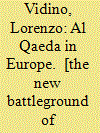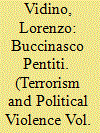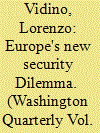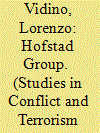|
|
|
Sort Order |
|
|
|
Items / Page
|
|
|
|
|
|
|
| Srl | Item |
| 1 |
ID:
068553


|
|
|
|
|
| Publication |
New Delhi, Viva Books, 2006.
|
| Description |
403p.
|
| Standard Number |
8130903733
|
|
|
|
|
|
|
|
|
|
|
|
Copies: C:1/I:0,R:0,Q:0
Circulation
| Accession# | Call# | Current Location | Status | Policy | Location |
| 051069 | 320.557094/VID 051069 | Main | On Shelf | General | |
|
|
|
|
| 2 |
ID:
105991


|
|
|
|
|
| Publication |
2011.
|
| Summary/Abstract |
Recently many scholars have focused their attention on the dynamics of radicalization, de-radicalization, and disengagement, yet most studies are based on indirect and/or data which is difficult to verify. An exception comes from Italy, where authorities have recently benefited from the insights of two former members of an al Qaeda-affiliated Tunisian network. The two have voluntarily described to authorities the process and factors that led them to their radicalization and encouraged them to abondon the network. Based on thousands of pages of their unpublished confessions, the article provides a case study of radicalization that is rich in detail and uniquely reliable.
|
|
|
|
|
|
|
|
|
|
|
|
|
|
|
|
| 3 |
ID:
090948


|
|
|
|
|
| Publication |
2009.
|
| Summary/Abstract |
After the September 11, 2001, attacks, governments throughout the world rushed to improve their counterterrorism policies. Several countries tightened legislation, increased resources available to their intelligence and law enforcement agencies, and established repressive policies to uncover and prosecute terrorist networks. Policymakers, fearing an imminent attack, understandably focused their attention on aggressive methods. Yet, over the last few years, many governments have started thinking about more nuanced, comprehensive, and long-term counterterrorism policies, understanding that simply trying to dismantle terrorist networks is like playing a never-ending game of "whack-a-mole," unless steps are also taken to prevent the radicalization of scores of potential new militants.
|
|
|
|
|
|
|
|
|
|
|
|
|
|
|
|
| 4 |
ID:
077786


|
|
|
|
|
| Publication |
2007.
|
| Summary/Abstract |
Between 2003 and 2006, members of the so-called Hofstad group planned various terrorist attacks inside the Netherlands, including the assassination of controversial filmmaker Theo van Gogh. Amateurish in its modus operandi and composed mostly of second-generation Muslim immigrants, Hofstad perfectly exemplifies the new terrorist networks that are growing in most European countries. Its perception of Europe as a battlefield of jihad, no less critical than Iraq or Afghanistan, signifies the break from the networks that operated in the continent in the 1990s. Its amorphous structure and lack of ties with international networks make Hofstad the quintessential example of the homegrown terrorism that is worrying European intelligence agencies.
|
|
|
|
|
|
|
|
|
|
|
|
|
|
|
|
| 5 |
ID:
087383


|
|
|
|
|
| Publication |
2009.
|
| Summary/Abstract |
Over the last few years, much attention has been devoted to the phenomenon of homegrown jihadist networks in the West. Most analyses have been based on the dual assumption that this phenomenon has manifested itself only extremely recently and that it is largely limited to Europe. While these two assertions are not completely unfounded, they do not take into consideration significant anecdotal evidence pointing to a long history of homegrown networks inspired by radical Islam operating within the United States. After an extensive overview of such history, the article analyzes the phenomenon of radicalization in America in comparison to Europe and the evolution of U.S. authorities' reaction to it.
|
|
|
|
|
|
|
|
|
|
|
|
|
|
|
|
|
|
|
|
|